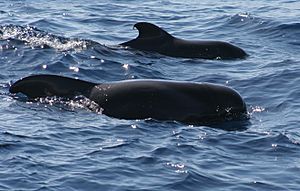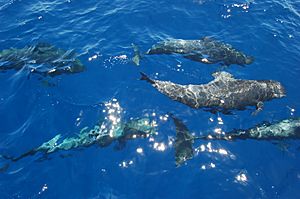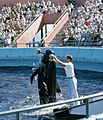Short-finned pilot whale facts for kids
Quick facts for kids Short-finned pilot whale |
|
|---|---|
 |
|
| Short-finned pilot whale surfacing | |
 |
|
| Size compared to an average human | |
| Conservation status | |
| Scientific classification | |
| Genus: |
Globicephala
|
| Species: |
macrorhynchus
|
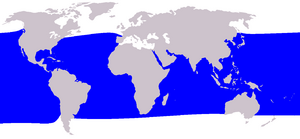 |
|
| Range of the short-finned pilot whale | |
The short-finned pilot whale (Globicephala macrorhynchus) is a type of dolphin. It belongs to the oceanic dolphin family, even though it's called a "whale." It's one of two kinds of pilot whales, the other being the long-finned pilot whale.
These whales live all over the world. There are about 700,000 of them. They are found in the Pacific, Atlantic, and Indian Oceans. Due to global warming, their homes are slowly moving north. Males are usually 4 to 6 meters long, and females are 3 to 5 meters. They are mostly black or dark gray. You can tell them apart from long-finned pilot whales by their shorter flippers and fewer teeth. They mainly eat fast-moving squid, often diving deep, sometimes over 1,000 meters!
Short-finned pilot whales are very playful and social. They usually travel in groups called pods, with 10 to 30 family members. Sometimes, hundreds of them gather together. Like killer whales, their pods are often led by an older female. Females can live a long time after they stop having babies. Males often mate with many females, and there are usually more females than males in a pod.
Sometimes, whole pods get stuck on beaches, which is called mass stranding. This might happen because of accidents, problems with their biosonar (like natural sonar), injuries from loud military sonar, or sickness. People used to hunt these whales a lot, and some hunting still happens today in places like Japan. However, many international agreements now protect them.
Contents
What's in a Name?
The name "pilot whale" comes from an old idea. People once thought that a leader "piloted" the pod. Other names for them include "pothead whale," because of their round heads. They are also called "blackfish," which is a general name for small, dark-colored toothed whales. This group includes animals like the pygmy sperm whale and false killer whale.
Scientists study the DNA of these whales. They found that short-finned pilot whales around the world don't have much variety in their mitochondrial DNA. But a study in 2014 found a special type of DNA in the Caribbean.
How They Evolved
Scientists think there are three main types of short-finned pilot whales. These are the Shiho, Naisa, and Atlantic types. The Shiho and Naisa types are actually like different groups within the same species. The Shiho group separated about 17,500 years ago. The Naisa group lives in the Pacific, Indian, and Atlantic Oceans. The Shiho group is found in the eastern Pacific Ocean. The Pacific Ocean acts like a partial barrier, keeping these two groups mostly separate.
The Atlantic group separated from the Naisa group about 12,500 years ago. More studies are needed to see if the Atlantic and Indian/western-central Pacific pilot whales are different enough to be considered separate groups too.
Appearance
Short-finned pilot whales are usually black or dark gray-brown. They have a thick tail, pointed tail tips, and a round head. Their dorsal fin (the fin on their back) is broad and curved. They often have lighter gray or white patches. These patches can be a saddle shape behind the dorsal fin, an anchor shape under their chin and belly, or a mark behind their eye. These markings can look different in various groups of whales.
For example, in Japan, there are two types:
- The Shiho type is larger. Females are 4-5 meters, and males are 5-6 meters. They have a white patch on their back and a round head.
- The Naisa type is smaller. Females are 3-4 meters, and males are 4-5 meters. They have a flatter head and a darker patch on their back.
When baby short-finned pilot whales are born, they weigh about 60 kilograms (132 pounds). They are about 1.4 to 1.9 meters (4.6 to 6.2 feet) long.
It can be tricky to tell short-finned and long-finned pilot whales apart. But as their names suggest, short-finned pilot whales have shorter flippers. Their flippers are about one-sixth of their body length. They also have fewer teeth (7-9 in each row). Both types of pilot whales live about 45 years for males and 60 years for females. Long-finned pilot whales are generally bigger. Short-finned pilot whales prefer warmer, tropical waters, while long-finned pilot whales live in cooler areas.
Where They Live
Short-finned pilot whales live in warm and mild parts of the Indian, Atlantic, and Pacific Oceans. They can be found both near coasts and far out at sea. In the northwest Atlantic, they live from Georges Bank down to tropical areas. Here, their home overlaps with the long-finned pilot whales.
Off the coast of Japan, the Shiho and Naisa types live in different areas. The Naisa type prefers the warm waters of the Kuroshio Current. The Shiho type lives in the colder waters of the Oyashio Current. Beyond Japan, the Naisa type is found in Southeast Asia, the Indian Ocean, and Hawaii. The Shiho type lives off California and Peru.
Pilot whales often stay in the same places year-round. These places include Hawaii, the U.S. and British Virgin Islands, and parts of California. However, some groups move with the seasons as water temperatures change.
Short-finned pilot whales used to be common off Southern California. But they mostly disappeared after a strong El Niño event in 1982-1983. They have only been seen rarely since then, mostly during warm water years.
These whales are important for the whale-watching industry in some areas. Places like Madeira, Hawaii, and the Canary Islands have groups of pilot whales that live there all the time. We don't know much about how whale-watching affects them. But loud boat noises might make it hard for them to talk to each other. Many countries have rules to help keep whale-watching safe for the animals.
Behavior and Life Cycle
Social Lives
Short-finned pilot whales live a long time and are very social. They usually live in pods of 10 to 30 whales. Sometimes, groups of several hundred have been seen. These pods are very stable. They are often led by an older female, much like killer whales. However, a study in Hawaii found that pods there are more like family groups. Closely related whales stay together.
Pilot whales are known for being playful at the surface. They do things like "lobtailing," which is slapping their tails on the water. They also "spy-hop," which means poking their heads out of the water to look around. Whales in a pod also help each other. For example, non-parent whales might help take care of young ones. This is called alloparental care.
Reproduction
Male pilot whales mate with many females. Pods often have about one adult male for every eight adult females. When it's time to mate, males might leave their pod for a short time. They mate with females from other pods, then return to their own. This helps prevent inbreeding.
Female pilot whales are ready to have babies when they are about 7 to 12 years old. They have a calf every five to eight years, usually having 4 to 5 calves in their lifetime. A baby whale will drink its mother's milk for at least two years. Many continue to drink milk for five years. Some females might even produce milk for up to 15 years after their last calf is born. Females usually stop having babies around age 40, but they can live to be over 60.
Foraging and Diet
Scientists are still learning about what short-finned pilot whales eat and how they find food. They are known to be deep divers. They often hunt along the steep slopes of the ocean floor. Their main food is squid, but they also eat some fish and octopus. They have been recorded diving over 1,000 meters (3,340 feet) deep for 21 minutes! But most dives are around 700 meters (2,300 feet) and last about 15 minutes.
When hunting, a pod might spread out up to 800 meters (half a mile) to find food. Pilot whales are sometimes called the "cheetahs of the deep." This is because they chase squid at high speeds hundreds of meters underwater.
Population Status
There are about 700,000 short-finned pilot whales in total. However, many parts of the ocean where they live haven't been fully studied. So, the actual number could be much higher.
In the western Pacific, there are about 5,300 whales in Northern Japan and over 53,000 in Southern Japan. About 7,700 live in the eastern Sulu Sea (Philippines). In the Eastern tropical Pacific, there were an estimated 589,000 whales in 2000. The group living near Tenerife, Spain, is much smaller, with only about 350 whales.
In U.S. waters, there are three main groups: along the East Coast, West Coast, and around Hawaii. The West Coast group has about 800 whales, and the East Coast group has about 21,500. These numbers come from sightings by boats and planes. It's hard to tell short-finned and long-finned pilot whales apart at sea. This makes it difficult to get exact numbers.
Hawaii is home to the Naisa-type short-finned pilot whale. These whales seem to live in three separate communities around the islands. There are no exact numbers for each community. But in all Hawaiian waters, there are an estimated 90,000 to 200,000 short-finned pilot whales.
Short-finned pilot whales are often seen in the Canary Islands. They are also common off West Africa, around the Maldives, and in the northern Indian Ocean. But we still don't have good global numbers or trends for this species.
Threats to Pilot Whales
Natural Dangers and Strandings
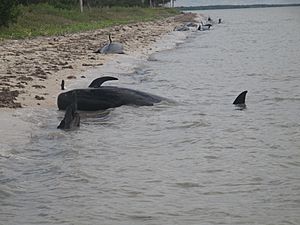
There are no recorded cases of natural predators hunting pilot whales. But killer whales or large sharks might sometimes attack them. Most information about pilot whale deaths comes from mass strandings. This is when many whales get stuck on a beach. Many theories try to explain why this happens:
- They might accidentally swim into shallow water.
- Problems with the Earth's magnetic field might affect their navigation.
- Loud military sonar could injure or confuse them.
- Sick whales might lead the rest of the group astray.
Because pilot whales have strong social bonds, rescue attempts after strandings are often difficult. Whales might swim back to shore if they hear their group members calling from the beach. If you ever see a stranding, it's important to contact local authorities right away.
Human Activities
People have hunted short-finned pilot whales for many centuries, especially in Japan. This hunting continues today in some parts of Japan and the Lesser Antilles. Whales are often hunted using "drive fisheries." This is where boats herd the whales towards the shore, where they are then killed in shallow water. Other methods include harpooning.
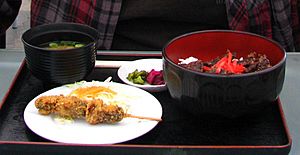
In some Japanese restaurants, pilot whale meat is served as sashimi or grilled steaks. The meat is high in protein and low in fat. It is considered an important part of some cultures.
Like many ocean animals, pilot whales can get caught in fishing gear. This includes gill nets and long lines. If they get tangled, they might drag the gear, which can make them tired, hurt them, or make it hard to find food. This can lead to them not having babies or even dying. Whales can also be hit by boats, which can be deadly.
Pilot whales are top predators, so they can build up harmful chemicals in their bodies. These chemicals, like heavy metals, can affect their health and ability to reproduce. This is a growing concern for people who eat pilot whale meat.
Living in Captivity

Short-finned pilot whales have been kept in marine parks in places like California, Hawaii, and Japan since the late 1940s. Historically, many of them did not live long in captivity. However, one famous pilot whale named Bubbles lived to be over 50 years old. She was at Marineland and later SeaWorld California.
Climate Change
As the Earth gets warmer, short-finned pilot whales are expected to move to cooler waters further north. This could mean they might start to mix and even breed with long-finned pilot whales. Their northern movement has already been seen in the Northeast Atlantic.
Like many other species, pilot whales will likely be affected by changes in their food sources. Their homes might also be damaged. These issues, combined with human activities like boat traffic and pollution, could lead to a decline in their numbers.
Protecting Pilot Whales
The short-finned pilot whale is listed as "Data Deficient" by the IUCN Red List. This means we don't have enough information about them in many parts of the world, especially in the Southern Hemisphere.
Several international agreements help protect short-finned pilot whales. These include:
- The Agreement on the Conservation of Small Cetaceans of the Baltic, North East Atlantic, Irish and North Seas (ASCOBANS)
- The Agreement on the Conservation of Cetaceans in the Black Sea, Mediterranean Sea and Contiguous Atlantic Area (ACCOBAMS)
These groups work to reduce threats to whales by improving our knowledge and enforcing conservation rules. The species is also covered by other agreements in Western Africa and the Pacific Islands. In the United States, they are protected under the Marine Mammal Protection Act. Globally, they are listed in Appendix II of the Convention on International Trade in Endangered Species. This means international trade of these whales is controlled to protect them.
Around the world, many efforts are trying to help whales. For example, in the U.S., NOAA Fisheries has a plan to reduce injuries and deaths of marine mammals caught in fishing nets. This plan includes changing fishing gear and teaching fishermen.
In places where pilot whales live near the coast, like the Canary Islands and Hawaii, scientists can study them using photo-identification. This method uses unique marks on their dorsal fins to identify individual whales from photos. This helps researchers track their movements and life stories over time. Other research methods include satellite tagging, listening to their sounds, and studying their genetics. However, there haven't been many long-term studies on this species. This makes it hard to know their exact numbers and how to best protect them. More research is needed to understand the global status of short-finned pilot whales.
Images for kids
-
Short-finned pilot whales spy hopping off of Guam
-
Bubbles, the pilot whale, performing at Marineland of the Pacific, 1962
See also
 In Spanish: Calderón tropical para niños
In Spanish: Calderón tropical para niños





